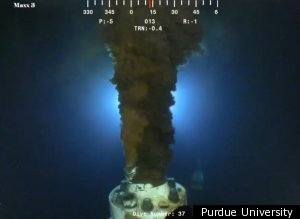
By John Rudolf
On April 25, 2010, BP assured the Gulf Coast that a disaster wasn't unfolding.
Five days earlier, the Deepwater Horizon, a BP-leased rig in the Gulf of Mexico, had suffered a massive blowout, killing 11 men and seri ously injuring 17 others. The floating platform burned for two days, then sank in 5,000 feet of water. Less than 48 hours later, BP discovered a leak from its deep-sea well.
BP knew that the well, tapping a reservoir of at least 50 million barrels, could release vast amounts of crude oil, dwarfing tanker-sized spills. But the company's experts quickly calculated that the well was releasing just 1,000 barrels a day, an estimate it provided to the Coast Guard shortly after the leak was found. The Coast Guard made BP's figure public on April 24.
At a press conference the next day, a New Orleans reporter asked whether the leak could produce a spill on par with the Exxon Valdez disaster. Doug Suttles, an engineer and BP's chief operating officer for exploration and production, told him it could not.
There were "many, many restrictions" within the well and other drilling equipment on the seafloor, Suttles said, dramatically slowing the release of oil. "This is a long way away from something more significant."
Events soon proved Suttles' reassurances to be terribly misplaced. The leak rate at the time was far, far higher than BP portrayed to the Coast Guard — more than 50,000 barrels per day from the moment the rig went down until the well was capped 87 days later, a government-led panel of physicists and engineers would conclude that August. At that rate, the leak had produced an Exxon Valdez-sized spill at least every five days.
Today, more than a year after the spill ended, serious questions remain about BP's role in estimating the size of the undersea gusher.
What is clear is that BP failed, throughout the event, to produce an accurate estimate of the size of the leak to the federal government or the public. Also readily apparent is the company's strong vested interest in downplaying the size of the spill: federal pollution laws stipulate fines as high as $4,300 for every barrel of oil unlawfully discharged into U.S. waters.
Less obvious is precisely how and why the multinational energy giant fell so short in its efforts to determine the scale of the disaster. BP officials have adamantly denied deliberately lowballing the size of the spill, arguing that the company was overwhelmed by the technical challenge of measuring the deep-sea leak and claiming that the government shares equal responsibility for the early flow estimates.
Yet a review by The Huffington Post of thousands of pages of documents, along with interviews with dozens of engineers, scientists and government officials, has uncovered new information challenging BP’s portrayal of its efforts to measure the leak — and found the company may have withheld crucial data on the well’s flow rate from federal responders during the spill.
According to federal officials, BP was solely responsible for producing the very first spill estimate of 1,000 barrels per day, a figure which led to a sense of complacency about the seriousness of the event among some federal and state responders at the outset of the disaster, the presidential commission on the oil spill concluded in January 2011. BP has never publicly acknowledged generating this figure and even the commission’s investigators could not determine the methodology used to produce it.
Documents and interviews also indicate that BP, using reservoir data, computer modeling and imagery of the leaking pipe, may have had the ability to calculate a far more accurate estimate of the well's flow rate early on in the spill than it provided to the government. The company either never fully ran those calculations or their results were not disclosed to federal responders.
"There was no lack of highly-coordinated work going on on that topic right from the beginning," said an oil industry consultant directly involved in the effort to stop the leak, who requested anonymity because he may be called to testify in criminal and civil litigation related to the spill. “If all of those calculations were run, the flow rate could be fairly accurately predicted.”
Through a spokeswoman, BP declined to answer any questions from The Huffington Post about the company's efforts to measure the leak. Current and former BP officials either did not respond to requests for comment or declined to be interviewed.
Article courtesy of huffingtonpost.com

